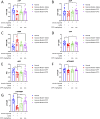Improvement on mitochondrial energy metabolism of Codonopsis pilosula (Franch.) Nannf. polysaccharide
- PMID: 40520160
- PMCID: PMC12162984
- DOI: 10.3389/fphar.2025.1545356
Improvement on mitochondrial energy metabolism of Codonopsis pilosula (Franch.) Nannf. polysaccharide
Erratum in
-
Correction: Improvement on mitochondrial energy metabolism of Codonopsis pilosula (Franch.) Nannf. polysaccharide.Front Pharmacol. 2025 Jul 14;16:1638311. doi: 10.3389/fphar.2025.1638311. eCollection 2025. Front Pharmacol. 2025. PMID: 40727102 Free PMC article.
Abstract
Ethnopharmacological relevance: Codonopsis pilosula (Franch.) Nannf. (CP) is one of the most popular Qi-invigorating herbal medicines and has been extensively used to promote health and vitality in China for a long time. Codonopsis pilosula (Franch.) Nannf. polysaccharide (CPP) is the principal active components of CP, which is considered as the reason for CP widespread application. However, it has not been revealed that CPP exert a Qi-invigoration effect by protecting mitochondria and/or improving mitochondrial function in the existing traditional Chinese medicine theories.
Aim of the study: We extracted CPP from C. pilosula and investigated the effects of CPP on energy metabolism and mitochondrial protection.
Methods: Based on the mice chronic hypoxia model for imitating the energy deficiency state of the human body, which was administered with CPP by oral gavage daily for 10 days, mitochondrial permeability transition (MPT), lipid peroxidation product malondialdehyde (MDA) in brain, mitochondrial respiratory function, the levels of adenosine triphosphate (ATP), adenosine diphosphate (ADP) and adenosine monophosphate (AMP) in liver cells were assayed. Adenylate energy charge (AEC), total adenylate pool (TAP), ATP/ADP, and ATP/AMP ratios were calculated.
Results: CPP can inhibit the formation of MDA in mice brains, decrease oxygen consuming rate and respiratory control ratio (RCR) of liver mitochondria, increase levels of ATP, TAP and AEC in liver cells under chronic hypoxia condition.
Conclusion: CPP can possess and improve mitochondrial energy metabolism and bioenergetic levels.
Keywords: Codonopsis pilosula (Franch.) Nannf. polysaccharide; adenosine triphosphate; anti-hypoxia; energy metabolism; mitochondria; mitochondrial respiratory function.
Copyright © 2025 Li, Zhang, Li, He, Fu, Zhu, Hu, Qiu, Gong and Zhang.
Conflict of interest statement
The authors declare that the research was conducted in the absence of any commercial or financial relationships that could be construed as a potential conflict of interest.
Figures





Similar articles
-
The Effect and Mechanism of New Processing Method of Codonopsis pilosula on Endocrine Physique Index in Rats.Comput Math Methods Med. 2022 Apr 18;2022:7703612. doi: 10.1155/2022/7703612. eCollection 2022. Comput Math Methods Med. 2022. Retraction in: Comput Math Methods Med. 2023 Jun 28;2023:9858791. doi: 10.1155/2023/9858791. PMID: 35479189 Free PMC article. Retracted.
-
The effect and mechanism of Codonopsis Radix and its active components tangshenoside I and lobetyolin on preventing gastric ulcer based on spectrum-effect relationship.J Ethnopharmacol. 2025 Jul 11;353(Pt A):120281. doi: 10.1016/j.jep.2025.120281. Online ahead of print. J Ethnopharmacol. 2025. PMID: 40653041
-
Synergistic gut microbiome-mediated degradation of Astragalus membranaceus polysaccharides and Codonopsis pilosula polysaccharides into butyric acid: a metatranscriptomic analysis.Microbiol Spectr. 2025 Jul;13(7):e0303924. doi: 10.1128/spectrum.03039-24. Epub 2025 May 27. Microbiol Spectr. 2025. PMID: 40422281 Free PMC article.
-
Dang shen [Codonopsis pilosula (Franch.) Nannf] herbal formulae for chronic obstructive pulmonary disease: a systematic review and meta-analysis.Phytother Res. 2015 Feb;29(2):167-86. doi: 10.1002/ptr.5248. Epub 2014 Oct 22. Phytother Res. 2015. PMID: 25336444
-
The Black Book of Psychotropic Dosing and Monitoring.Psychopharmacol Bull. 2024 Jul 8;54(3):8-59. Psychopharmacol Bull. 2024. PMID: 38993656 Free PMC article. Review.
References
LinkOut - more resources
Full Text Sources
Research Materials
Miscellaneous

